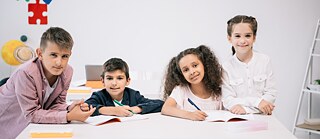Practical tips
Multilingualism – An asset in promoting literacy

Multilingual learners consolidate reading strategies more effectively if they can draw on all their language skills – an approach that valorizes and makes the most of their previous knowledge.
The pupils are given an assignment to do in class: to write a letter to someone about a new extra-terrestrial friend of theirs and what they experience on the alien’s planet.
Sitting together in groups of five, the kids get to work on it while talking about what they’ve written. Klarissa is writing a letter to the mayor, Mr Jansen. It starts like this: “Дорогой Мистер Янсен, я была на Элементар планетe.” She tells her classmates what she’s writing: “Dear Mr. Jansen, I’ve been to the planet ‘Elementary’.”
Samira reads her Turkish letter aloud: “Sevgili arkadaşlar, uzaylı arkadaşımla birlikte bir hafta geçirdim. Bana kendi okulunu gösterdi.” And then translates into German: “Liebe Freundinnen und Freunde, ich habe eine Woche mit meinem außerirdischen Freund verbracht. Er hat mir seine Schule gezeigt.” (Dear Friends, I spent a week with my extraterrestrial friend. He showed me his school.)
“I did that too,” says Klarissa, adding after a pause for reflection: “So we'll write that we flew back on an eraser-spaceship.” “Yes,” chimes in Pascal. “Let’s say the very next day.” (Video transcript)
This authentic exchange in a school classroom makes it clear that multilingual interaction can be an asset for teaching. And combining languages proves particularly pragmatic and appropriate when two or more learners have a command of the same language. Multilingual kids learn early on how to adapt the linguistic resources available to them to monolingual and multilingual communication so their interlocutors will understand them. This gives them a special skill: the ability to switch back and forth quickly and easily between the languages they know according to the situation (cf. Tracy, 2008)
Activating multilingualism for learning purposes
Multilinguals don’t segregate their different languages into strictly separate systems. Instead, they have an overall repertoire of linguistic tools at their disposal. And they can draw on that whole repertoire when speaking to other multilinguals, often mixing or switching languages in mid-conversation (cf. Cantone, 2007) – which makes perfect sense in conversations between bilinguals or multilinguals, so it’s a sign of competent usage of language (cf. Tracy, 2008). Languages are a medium of central importance to learning at school. So it’s worth it to actively utilize the pupils’ entire repertoire of languages as a classroom resource, which is a way to facilitate learning for multilingual kids.In multilingual teaching practice, teachers draw on the whole range of their multilingual pupils’ linguistic, intellectual and communicational potential to help them acquire knowledge and skills – and to drive home to them that their multilingualism is an asset.
In cooperative forms of learning in particular, it makes sense for learners with a command of the same foreign languages to work together and to interact in all the languages they know (cf. Celic & Seltzer, 2011). However, when addressing the whole class or a larger group within the class, or when writing to a general audience, they must use the language understood by as many addressees as possible.
Young learners may need help with this. So, teachers should provide linguistic aids to help them meet standard and academic language requirements (usually in German). Examples of useful aids would be “concept maps”, “definition cards” and “learning posters”.
Using overall language skills to promote literacy
Literacy researchers distinguish between lower- and higher-level processes involved in learning to read (cf. e.g. Lenhard, 2013). Children first need to automatize lower-level processes in reading, e.g. letter-sound correspondence and word recognition. Only then do they possess the cognitive resources required for higher-level processes, i.e. reading comprehension.However, higher-level processes, such as applying knowledge about different types of texts and reading strategies, are not directly tied to a specific language. Which means that if a child has already learnt reading strategies in Turkish, for example, the same strategies can be applied to reading German texts. So it’s plausible that children may acquire and consolidate reading strategies more effectively and understand texts better if they use all the languages available to them rather than just one when interacting with texts. The Multilingual Reciprocal Reading method is based on this assumption, combining the principle of interactive learning with the didactic resources of multilingualism.
“Translanguaging” is a term coined by Welsh linguist Cen Williams. It was later adopted by Ofelia García, a New York-based expert in multilingual education. She describes translingual behaviour as a natural and legitimate form of communication (cf. Otheguy, García & Reid, 2015) with great didactic potential for the classroom (cf. García, Ibarra Johnson & Seltzer, 2017).
In everyday life, however, languages are often treated as countable units, giving rise to the misconception that these constructed boundaries (e.g. German vs. English) also exist in the minds of polyglots. The central tenet of the translanguaging approach, on the other hand, is that clearly defined boundaries between languages don’t exist in the mind.
Consequently, standard correctness in language use and educational language skills should be promoted on the basis of all the language resources available to young learners.